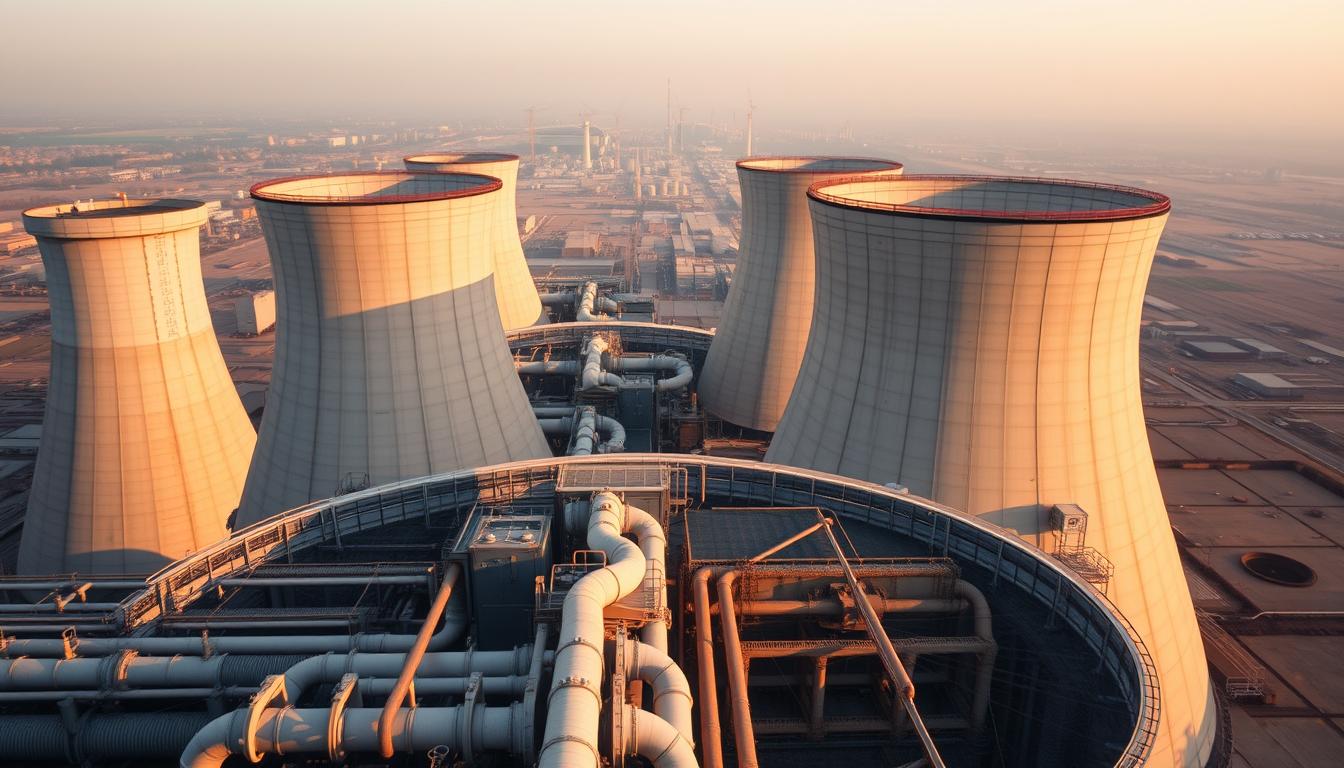I’m diving into cooling towers to give you a full picture of their role in industry. They play a key part in cooling down systems like HVAC, power plants, and factories. Knowing how cooling towers work helps us see their value in keeping things running smoothly and preventing overheating.
The American Society of Mechanical Engineers (ASME) says cooling towers are vital for heat exchange. The Cooling Technology Institute (CTI) also provides important advice on their performance. The U.S. Department of Energy points out their role in saving energy in factories. Let’s explore their functions and why they’re so important in cooling down industries today.
What is a Cooling Tower?
A cooling tower is a device that efficiently removes heat from water used in industrial processes and facilities. It works by exchanging heat, cooling the water before it’s recirculated. There are different types of cooling towers, each with its own way of working and efficiency.
Open cooling towers cool water by mixing it with air directly. They are simple and effective but can lose water and grow biological stuff. Closed cooling towers keep water and air separate, reducing water loss and contamination. They are more efficient but cost more to start.
Hybrid cooling towers mix open and closed systems. They use both direct and indirect cooling methods. The design of each type affects its performance and suitability for different needs. Knowing about these types helps choose the right cooling solution.
Key Components of Cooling Towers:
Cooling towers work well because of their key parts. Knowing these parts is key to keeping cooling systems running smoothly. The fill media is very important for heat exchange between water and air. Different designs of fill media increase the surface area, making cooling more efficient.
Fans are also critical for moving air through the tower. The choice between axial or centrifugal fans affects how well the tower works.
Drift eliminators play a big role in reducing water loss due to airborne moisture. They catch water droplets, boosting efficiency and saving water. The basin collects water that has gone through the system, making maintenance easy. Each part is important for the tower’s performance and should be made from the right materials for lasting use.
Materials like fiberglass and concrete are commonly used in cooling towers. Fiberglass is light and resistant to corrosion, great for many settings. Concrete, on the other hand, is strong and durable, ideal for bigger towers. Choosing the right materials is essential for a reliable and efficient cooling tower, affecting maintenance and costs.
Cooling Tower Operations and Efficiency:
Understanding how cooling towers work is key to better performance and saving energy. They remove heat from buildings or industrial processes through evaporation. This process transfers heat from water to the air efficiently.
Important metrics for cooling tower efficiency are the range and approach. The range shows the temperature difference between water entering and leaving. The approach shows how close the water temperature is to the air’s wet bulb temperature. By looking at these, I can find ways to make the cooling tower work better.
To boost cooling tower efficiency, I keep an eye on water flow and air circulation. Regular checks help avoid scaling and fouling, which hurt performance. Using best practices and reliable information helps make cooling towers more effective.
Applications of Cooling Towers:
Cooling towers are key in many industries, helping manage heat efficiently. In HVAC, they keep buildings at the right temperature. This makes spaces more comfortable and saves energy.
They are also vital in power plants. These towers handle the heat from making electricity. This keeps equipment safe and makes energy production more sustainable.
In industries like chemical processing and food, cooling towers are essential. They control temperatures, ensuring processes run smoothly. This is critical for keeping food safe and chemicals effective.
Cooling towers are vital in many areas. They help manage heat, making operations more efficient and sustainable. This shows how important they are in today’s industries.
Maintenance and Troubleshooting of Cooling Towers:
Effective cooling tower maintenance is key to keeping it running well and lasting longer. Regular checks help spot problems like scaling, corrosion, and microbial growth. Following the Cooling Technology Institute’s guidelines helps avoid costly repairs.
When troubleshooting, it’s important to look at each part and check the water quality. Scaling hurts heat transfer, while corrosion can damage the structure. Regular water treatment and anti-corrosion steps are essential to keep the tower in good shape.
Using ASHRAE Handbook tips, like watching water quality and doing regular maintenance, helps a lot. By focusing on upkeep and having a solid troubleshooting plan, cooling systems work better and safer. This means less downtime and lower repair costs.
